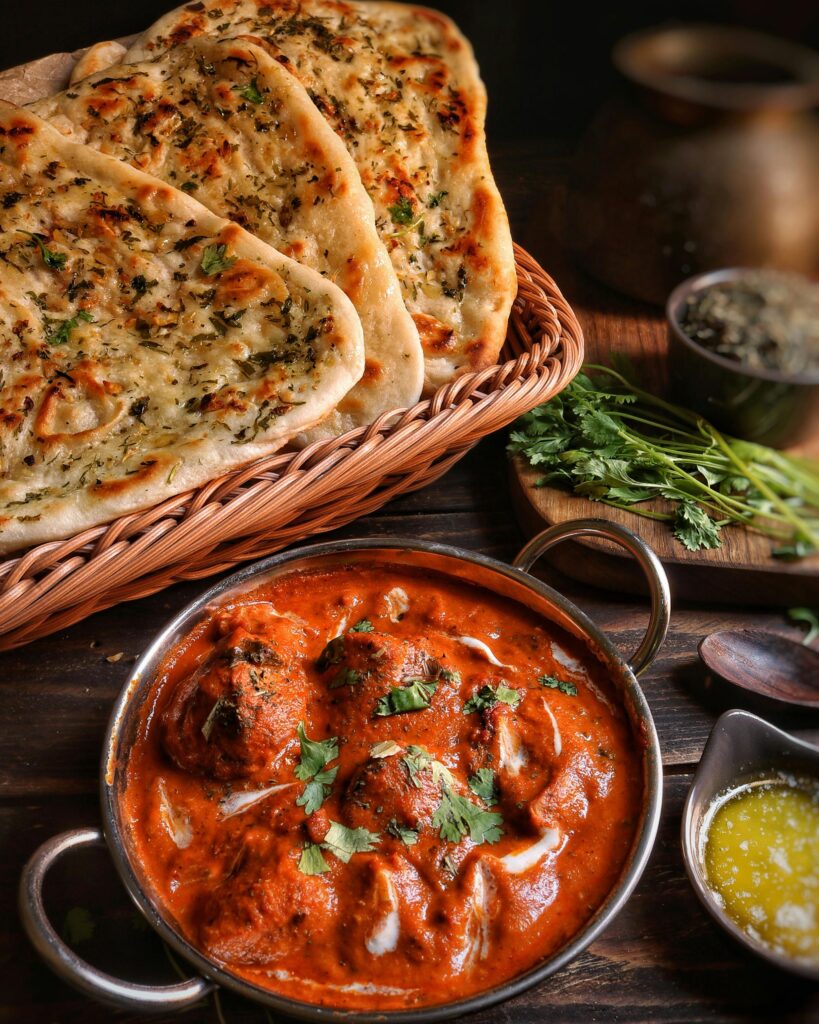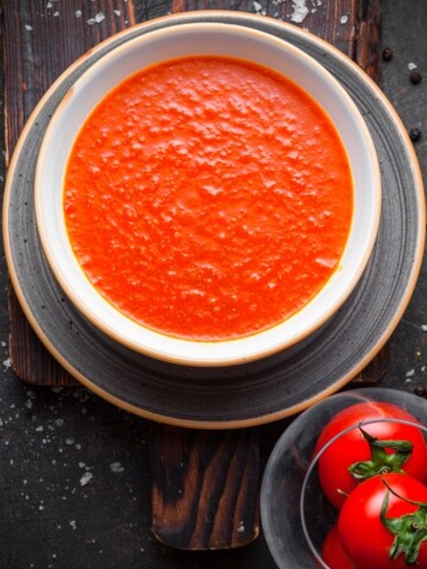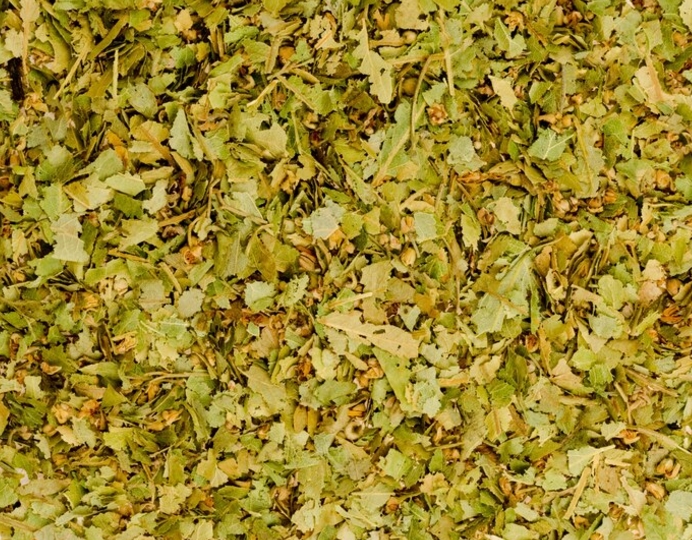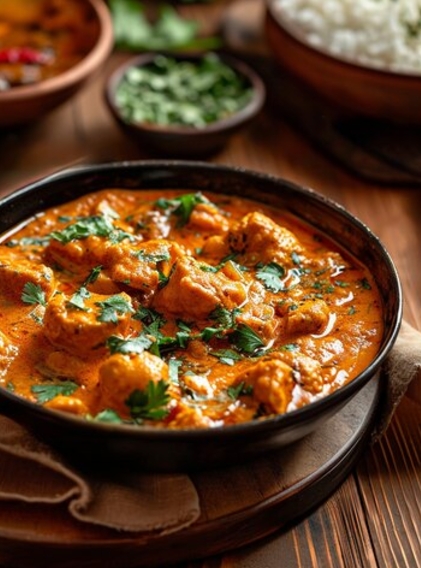For those who enjoy thick, creamy curries, butter chicken, also known as murgh makhani, is the perfect comfort food. This recipe, which originated in the busy kitchens of Delhi, India, blends a silky tomato-cream sauce with delicate, seasoned chicken. A curry that is as opulent as it is approachable is produced by the union of tart tomatoes, aromatic spices, and creamy butter.
What You Can Learn From This Recipe
Learn the skill of blending spices for a curry that will be remembered, as well as the secrets of flawlessly marinated and grilled chicken. Additionally, you will learn how to enhance the inherent aromas of spices by tempering them.
What I Love About This Recipe
Its adaptability—Butter Chicken is suitable for a joyful get-together, a family meal, or a relaxing evening at home. It is quite magical how the flavors combine to create a dish that is rich without being overpowering.
What’s the Best Way to Store Leftovers?
Keep leftovers in the fridge for up to three days in an airtight container. To preserve its texture, reheat it slowly on the stovetop with a little water or cream.
What to Serve With It?
Serve Butter Chicken with paratha, aromatic basmati rice, or warm naan. For a full dinner, serve with pickled onions or cucumber raita on the side. An ideal drink to pair with this dish is a glass of mango lassi.
Butter Chicken: Creamy Wonder
Description
One of the most recognizable dishes in Indian cooking is butter chicken, or murgh makhani. This rich curry blends marinated, grilled chicken with a smooth sauce made of cream and tomatoes and seasoned with flavorful spices. Butter Chicken is a popular dish all over the world because of its vivid orange color and ideal harmony of acidic, creamy, and spicy ingredients. For a decadent supper that works well for any occasion, serve it with rice, roti, or naan.
For the Chicken Marinade
For the Butter Sauce
Instructions
Preparing the Chicken
-
Marinate the Chicken
- In a large bowl, mix yogurt, lemon juice, ginger paste, garlic paste, turmeric, chili powder, garam masala, and mustard oil.
- Add the chicken pieces and coat them well.
- Cover and refrigerate for at least 4 hours or overnight.
-
Grill the Chicken
- Preheat a grill or stovetop grill pan.
- Cook the chicken pieces until slightly charred and cooked through. Set aside.
Making the Butter Sauce
-
Prepare the Base
- Heat butter and oil in a large pan over medium heat.
- Add ginger and garlic paste, sauté until fragrant.
-
Cook the Tomato Puree
- Add the tomato puree and Kashmiri chili powder.
- Simmer for 10–15 minutes until the oil separates.
-
Season the Sauce
- Stir in garam masala, sugar, and salt.
- Add grilled chicken to the pan.
-
Finish with Cream and Fenugreek
- Stir in heavy cream and kasuri methi.
- Simmer for 5–7 minutes.
Serve
-
- Garnish with a drizzle of cream and fresh cilantro.
- Serve hot with naan or rice.
Nutrition Facts
Servings 4
- Amount Per Serving
- Calories 500kcal
- % Daily Value *
- Total Fat 35g54%
- Saturated Fat 20g100%
- Cholesterol 150mg50%
- Sodium 800mg34%
- Potassium 700mg20%
- Total Carbohydrate 10g4%
- Protein 25g50%
* Percent Daily Values are based on a 2,000 calorie diet. Your daily value may be higher or lower depending on your calorie needs.
Note
- For a smoky flavor, add a piece of hot charcoal to the pot, cover it, and let the smoke infuse the curry for a few minutes.
- Adjust the spice level by increasing or decreasing the chili powder.
- Kasuri methi (dried fenugreek) is essential for authentic flavor—don’t skip it if possible.
Journey of Butter Chicken
Murgh Makhani, or butter chicken, is a meal that cuts over national boundaries and culinary barriers. Its narrative starts in the middle of the 20th century in the busy kitchen of the now-iconic restaurant Moti Mahal in the center of Delhi, India. According to the story, leftover tandoori chicken was cooked in a sauce made with tomatoes and enhanced with cream and butter. The end product was a delicious dish that quickly became a classic. This unintentional invention demonstrated how waste ingredients could be turned into culinary wonders and exemplified creativity and resourcefulness.
Historical Context: Where It All Began
The founders of Moti Mahal, Thakur Dass, Kundan Lal Jaggi, and Kundan Lal Gujral, are credited with creating Butter Chicken. These innovative cooks carried the tradition of tandoori cooking with them when they fled Peshawar during India's 1947 partition. They discovered the idea of combining tandoori chicken with a hearty tomato-based sauce while experimenting with tastes to satisfy their Delhi customers' palates. The dish that has since come to represent Indian cuisine, Butter Chicken, was made possible by this invention.
The Role of Butter and Cream
The sauce, a silky, opulent mixture of butter, cream, and tomatoes, is what makes Butter Chicken unique. Butter and cream give it a rich, velvety texture, and tomatoes give it their tang and vivid color. The earthy scent of the dried fenugreek leaves (kasuri methi) unifies the flavors. Even though these components are straightforward on their own, they work in perfect harmony to produce a sauce that is both decadent and cozy.
Equally important is the marinating process, which adds yogurt and spices to the chicken to soften and flavor the meat. The creamy sauce enhances the smokey depth that is added by grilling or tandoor-cooking the marinated chicken. Every component plays a part in creating the harmonious blend of flavors that makes this dish one to remember.
Modern Appeal: A Global Favorite
What began as a Delhi local favorite soon became well-known worldwide. From New York to London, Sydney to Singapore, butter chicken has become a mainstay in Indian restaurants all over the world. Its flavor balance, which appeals to a wide range of palates, is what makes it so popular everywhere: spicy yet creamy, tangy yet rich. It serves as a mild introduction to the world of strong spices and is frequently the first meal served to people who are not familiar with Indian cuisine.
Butter Chicken has spawned innumerable variations in contemporary kitchens. To accommodate dietary restrictions, some experiment with unconventional ingredients like coconut cream or almond milk, while others add paneer or tofu for a vegetarian twist. The dish's core ingredient—a rich, spicy tomato gravy—remains the same in spite of these changes.
Fun Facts and Cultural Tidbits
Did you know that Butter Chicken is frequently cited as the forerunner of Chicken Tikka Masala in Britain? The latter's creamy tomato base is directly inspired by Butter Chicken, although its spice blend is a little different.
The dish is so well-liked that it has appeared in international culinary contests and even appeared on menus at upscale restaurants all around the world.
Butter chicken, which represents coziness, friendliness, and decadence, is frequently consumed during festivities and get-togethers in India.
A Poetic Rhythm of Flavors
Imagine scooping up succulent bits of grilled chicken with a piece of warm, buttery naan dipped in Butter Chicken's creamy, tangy sauce. Every mouthful narrates a tale of custom, creativity, and culinary passion. The smoky scent takes you to the busy streets of Delhi, the cream calms your senses, and the spices dance on your palate.
Why We Love Butter Chicken
Butter chicken is an experience rather than merely a meal. Even if your home is halfway around the world, this type of comfort food will make you feel warm and fuzzy. This meal appeals to individuals of all ages and origins because it strikes the ideal balance between decadence and familiarity.
A Timeless Classic
The fact that Butter Chicken has spread from a little Delhi kitchen to dinner tables all around the world is evidence of its popularity. It is a dish worth appreciating because of its rich history and exquisite flavor. Therefore, the next time you savor Butter Chicken, pause to consider its origins, development, and the artistry involved in producing this gastronomic delicacy.
I appreciate you coming along on this tasty adventure with me! I hope you always have thick, creamy, and delicious butter chicken.












